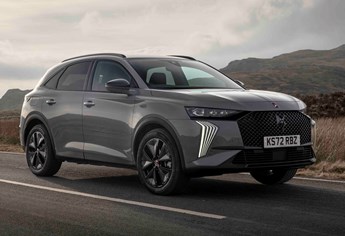We use cookies to ensure that we give you the best experience on our website. If you continue without changing your settings, we will assume that you are happy to receive all cookies on the Business Car website. However, if you would like to, you can change your cookies at any time

The start point for the best source of fleet information |
First drive: DS 7
Date: 16 May 2023 | Author: Sean Keywood

|
|
||||||||||||||||||
When the DS 7 first arrived in 2018 it was a significant model, as the first new car from DS since it became an independent brand from Citroen. Now, it's lost the former 'Crossback' tag from its name, and received a mid-life facelift. A medium SUV, it shares underpinnings with Stellantis group cousins such as the Peugeot 3008 and Vauxhall Grandland - though given DS's premium brand positioning it has more upmarket aspirations than those models. Design elements of the facelift include sharper front-end styling, with slimmer headlights - featuring LED pixel technology - and daytime running lights.
Slightly unusually, there is no pure petrol engine option with the DS 7. Instead, you have a choice of a 130hp diesel, or 225hp, 296hp, or 355hp petrol plug-in hybrids. We sampled the middle PHEV, which offers impressive shove for a family SUV, with a useful slug of performance when we needed to overtake a cyclist on a country road, for instance. However, the 1.6-litre petrol engine can sound a little uncouth under acceleration. A new, larger 14.2kWh battery allows an increased range of up to 42 miles between charges, meaning the BIK tax rate for company car drivers is reduced to 8%.
The DS 7's chassis is well up to coping with the power, with four-wheel drive offering an element of extra traction, and responsive steering even adds a slight sense of sportiness, which we found a bit surprising but not unwelcome. Ride quality we would generally describe as good, but not great - there can be an element of pitching about on undulating roads, possibly due to the effects of the heavy hybrid battery.
With our Opera-spec test car - one down from the top of the range - we found a very stylish and, to our eyes, attractive interior, particularly with cream-coloured trim highlighting some interesting contouring, and helping the analogue clock in the centre of the dashboard to stand out. A 12in infotainment touchscreen - redesigned with the facelift - is impressively large, clear and responsive, and well-integrated into the dash, rather than looking as if it was just plonked on top as many do these days. It also offers impressively clear images from the rear-view/360-degree camera system. A 12.3in driver display - now with updated graphics - also provides a useful range of information, integrating sat-nav instructions well.
Rear seat passengers benefit from their own climate controls and USB ports, and reasonable legroom. With the Opera grade's standard sunroof, taller adults might be a bit squeezed for headroom, although this can be mitigated since the back seats recline electrically. The 555-litre boot is a good size, and unlike with some plug-in hybrids isn't compromised by the battery compared with the diesel DS 7.
When we reviewed the DS 3, we noted that as a premium electric small SUV it didn't really have any direct rivals. This is not the case with the DS 7 as a larger plug-in hybrid - and comparison doesn't flatter it. Not only is the equivalent (in fact slightly more powerful) BMW X1 £6,000 cheaper to buy, it also offers significantly stronger expected residual values, with the DS 7 receiving a poor 32.9% rating from our data provider Kee Resources. This means that over a three-year/60,000-mile cycle, the DS is expected to cost nearly a whopping 22p-per-mile more to run than the X1 - and in fact even the larger equivalent BMW X3 comes out 6p ahead. Therefore, while the stylish DS does offer some good points, from a hard-nosed financial point of view it's difficult to recommend.
DS 7 Opera E-Tense 4x4 300
P11D: £56,485
Residual value: 32.9%
Depreciation: £37,904
Fuel: £7,049
Service, maintenance and repair: £2,374
Cost per mile: 78.87p
Fuel consumption: 41.5mpg
CO2 (BIK %): 27g/km (8%)
BIK 20/40% a month: £75/£151
Luggage capacity: 555 litres
Engine size/power: 1,598cc/200hp with 110hp and 113hp electric motors
Verdict |
6/10 |
|||
 |
|
 |
|
|











